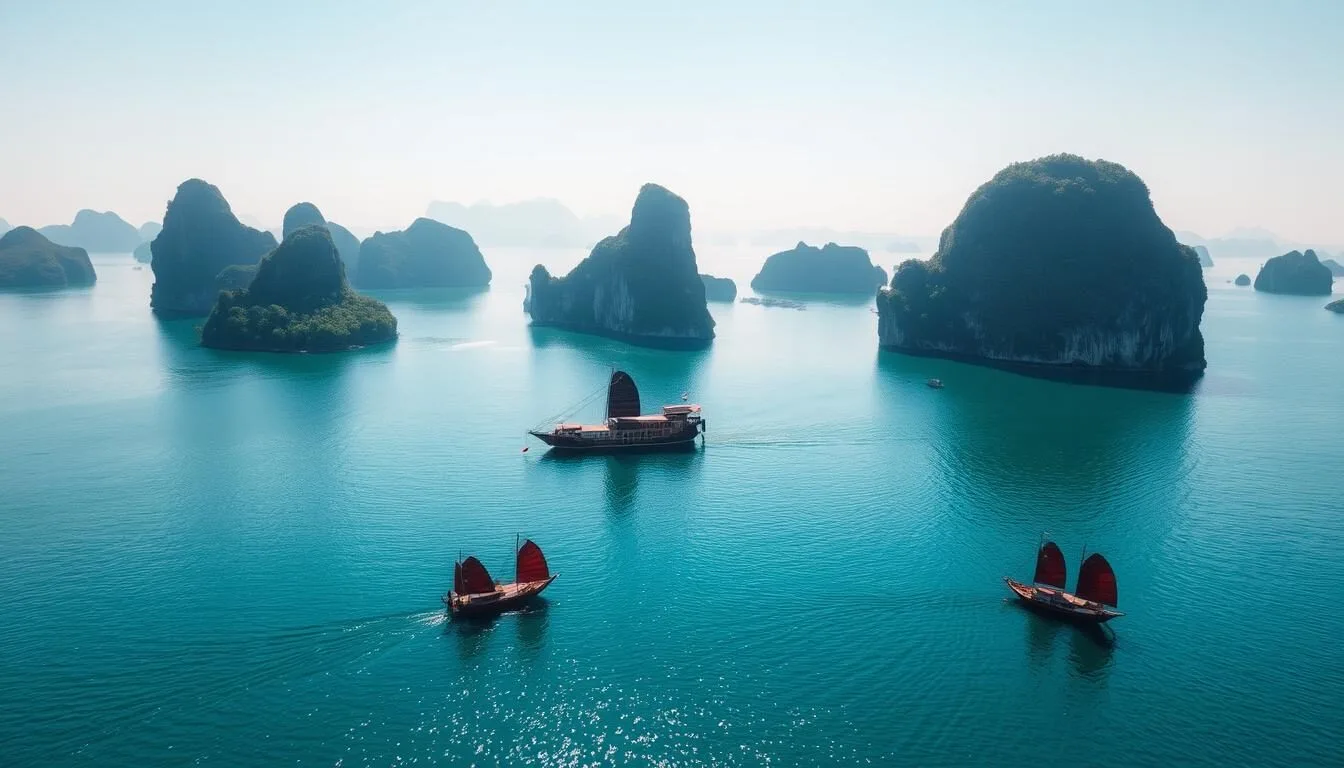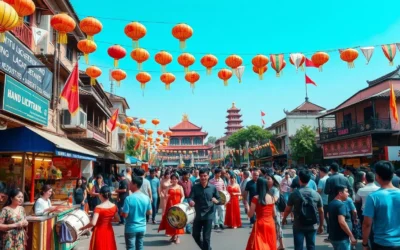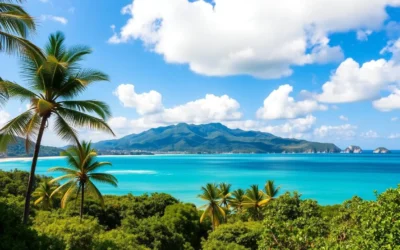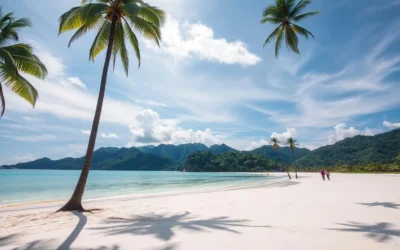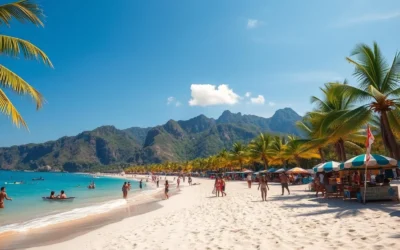✓ Accommodations✓ Flights✓ Rental Cars
You’ve likely heard of Halong Bay, one of Vietnam’s most iconic destinations, known for its stunning natural beauty and recognized as a UNESCO World Heritage Site. This breathtaking location is characterized by thousands of limestone islands and islets rising dramatically from emerald waters.
Spanning approximately 1,553 square kilometers with 1,969 limestone islands, Halong Bay is a marvel of geological significance, formed over 500 million years ago. As a popular tourist destination, it has attracted notable visitors like Mark Zuckerberg and Christina Aguilera. Despite its popularity, Halong Bay offers authentic experiences for all types of travelers.
This comprehensive guide will walk you through the best activities and attractions, helping you plan the perfect Halong Bay adventure. Get ready to explore one of the world’s most breathtaking UNESCO World Heritage sites.
Discovering the Wonder of Halong Bay
Halong Bay, a majestic spectacle in Northern Vietnam, beckons travelers to explore its enchanting beauty. Located approximately 180 km from Hanoi in Quang Ninh Province, this stunning destination is a must-visit for any traveler.
The UNESCO World Heritage Site
Halong Bay was recognized as a UNESCO World Heritage Site in 1994 due to its outstanding geological and geomorphological value. The bay is home to thousands of limestone islands and islets, creating a breathtaking seascape. The unique limestone karst formations have been shaped over millions of years through geological processes, making Halong Bay a distinctive natural wonder.
The bay’s emerald waters beautifully contrast with the towering limestone formations, creating a visually stunning landscape. Halong Bay is also known for its rich biodiversity, with numerous ecosystems both above and below the water, contributing to its cultural significance to Vietnamese identity and heritage.
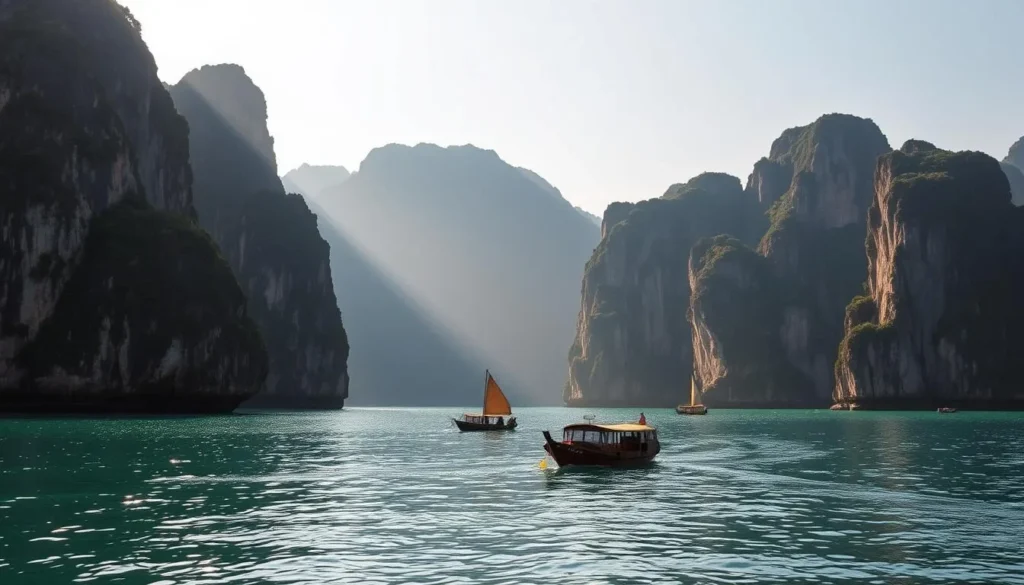
The Legend Behind the Bay
The name “Halong” translates to “descending dragon” in Vietnamese folklore. According to legend, dragons sent by the gods created the islands as a natural barrier against invaders, thus giving the bay its name. This legend adds a layer of mystique to the already enchanting landscape of Halong Bay, making it a fascinating destination for visitors.
As you explore Halong Bay, you’ll discover the magic that has captivated travelers for centuries. The bay’s unique landscapes and rich cultural heritage make it an unforgettable experience.
Best Time to Visit Halong Bay
To make the most of your Halong Bay adventure, understanding the seasonal changes is key. Halong Bay, located in Quang Ninh Province, Northern Vietnam, experiences a tropical monsoon climate with four distinct seasons, offering various experiences throughout the year.
Peak Season vs. Off-Peak Season
The peak season, from October to December, attracts international visitors with its pleasant weather, less humidity, and calm waters. During this time, you can enjoy a more vibrant atmosphere and a wide range of activities. However, it’s also the busiest period.
In contrast, the off-peak seasons offer fewer crowds and potentially lower prices, making it ideal for those seeking a more serene experience. Visiting during the off-peak season can be advantageous for a more peaceful exploration of Halong Bay.
Weather Considerations
Halong Bay’s weather varies significantly throughout the year. Winter (November-February) brings temperatures between 15-20°C, creating a misty and foggy atmosphere that’s both magical and cool. Summer (May-September) sees temperatures ranging from 25-35°C, perfect for swimming and kayaking.
The best months to visit are March-May, offering pleasant weather and fewer crowds, ideal for water activities. It’s advisable to avoid April 30th and May 1st due to the surge in local tourism.

June-August is the wettest period, making it less favorable. Checking with tour operators about potential cruise cancellations during storm season is recommended.
The timing of your visit significantly impacts your overall experience in Halong Bay. By choosing the right time, you can enhance your enjoyment and create lasting memories of this stunning destination.
How to Get to Halong Bay
Getting to Halong Bay is easier than you think, with several transportation options available. Located in Quang Ninh, Halong Bay is a popular destination that attracts travelers from around the world.
From Hanoi to Halong Bay
The distance from Hanoi to Halong Bay is approximately 180 km, and there are multiple ways to cover this distance. The fastest route is via the Hanoi-Hai Phong Expressway, which takes around 2 hours. Alternatively, you can take the more scenic route along the Red River Delta, which takes about 4 hours, including a rest stop. Most cruise operators offer convenient pickup services from hotels in Hanoi’s Old Quarter, making it easy for travelers to get to Halong Bay.
Transportation Options
You have several transportation options to choose from, depending on your budget, time constraints, and comfort preferences. You can hire a private car or join a shuttle bus service for more flexibility. If you’re coming from other major cities like Hai Phong, with Cat Bi International Airport, you can also plan your trip accordingly. Halong City serves as the gateway to this popular destination, with most cruises departing from Tuan Chau Marina.
| Transportation Mode | Duration | Cost |
|---|---|---|
| Private Car | 2-4 hours | $50-$100 |
| Shuttle Bus | 2-4 hours | $10-$30 |
| Cruise Operator Pickup | Varies | Included in cruise package |
Choosing the Perfect Halong Bay Cruise
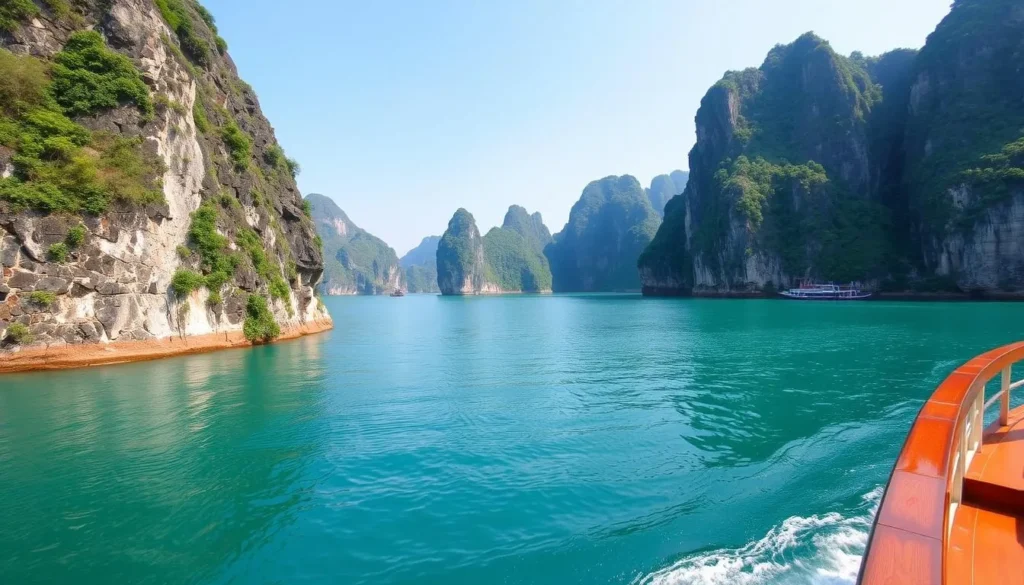
Halong Bay’s enchanting landscapes are best appreciated from the deck of a cruise, where you can soak in the tranquility and majesty of this UNESCO World Heritage Site. Cruising is the primary way to experience Halong Bay, with options ranging from day trips to multi-day adventures.
Day Trips vs. Overnight Cruises
When deciding on a Halong Bay cruise, one of the first considerations is whether to opt for a day trip or an overnight cruise. Day trips typically last 4-5 hours on the water, providing a glimpse into the bay’s beauty. In contrast, overnight cruises, which can be 2 days/1 night or 3 days/2 nights, offer a more comprehensive experience, allowing you to explore the bay’s hidden gems and enjoy the serene atmosphere in the evenings.
An overnight cruise is ideal for those who want to immerse themselves in the natural beauty of Halong Bay without the rush. It’s an opportunity to witness stunning sunsets, enjoy fresh seafood, and relax in a tranquil environment.
Luxury vs. Budget Options
Halong Bay cruises vary significantly in terms of luxury and budget options. Luxury cruises offer high-end amenities such as jacuzzis, floor-to-ceiling windows, and personal butlers, ensuring a lavish experience. On the other hand, budget options provide a more basic yet still enjoyable experience. When choosing a cruise, consider what amenities are important to you and select accordingly.
For a more intimate experience, it’s recommended to choose smaller boats that carry 20-30 guests rather than larger vessels with 50-60 people. This allows for a more personalized service and a closer connection with the natural surroundings.
What to Expect on Board
On a typical Halong Bay cruise, you can expect comfortable cabin accommodations, delicious dining experiences, and a range of scheduled activities. Most cruises include meals, activities, and transfers in their packages, so it’s essential to check what’s included before booking.
Some cruises offer unique experiences, such as cycling on Cat Ba Island or visiting less crowded areas like Lan Ha Bay or Bai Tu Long Bay. A 3-day/2-night cruise is often considered the best balance of sightseeing and relaxation.
When booking your cruise, it’s crucial to choose a reputable operator that maintains proper safety standards and environmental practices. This ensures not only a memorable experience but also a responsible and sustainable tourism approach.
Halong Bay, Vietnam: Best Things to Do – Top Picks
With its emerald waters and limestone karsts, Halong Bay offers a diverse range of experiences that cater to all interests. As you explore this UNESCO World Heritage Site, you’ll discover a plethora of exciting activities and breathtaking sights.
Exploring Sung Sot Cave (Surprise Cave)
Sung Sot Cave, also known as Surprise Cave, is the largest and most spectacular cave in Halong Bay. Known for its impressive chambers and colorful lighting, this cave is a must-visit attraction. As you venture inside, you’ll be amazed by the stunning formations and the sheer scale of this natural wonder.
Visiting Ti Top Island
Ti Top Island is a popular destination within Halong Bay, featuring a crescent-shaped beach and a panoramic viewpoint. To reach the viewpoint, you’ll need to climb over 400 steps, but the breathtaking views of the surrounding islands and emerald waters make the effort worthwhile.
![]()
Discovering Cua Van Floating Village
Cua Van Floating Village is one of the largest floating communities in Halong Bay, where generations of fishermen have lived and thrived. Visiting this village offers a unique insight into the local culture and way of life, providing a truly immersive experience.
Admiring Trong Mai Islet (Fighting Cock Islet)
Trong Mai Islet, commonly known as Fighting Cock Islet, is an iconic symbol of Halong Bay. Resembling two roosters facing each other, this distinctive formation is even featured on Vietnam’s 200,000 VND note. It’s a striking sight that adds to the rich tapestry of Halong Bay’s natural beauty.
Exploring Thien Cung Cave (Heavenly Palace)
Thien Cung Cave, or Heavenly Palace, is renowned for its intricate stalactites and stalagmites, which resemble a grand palace. This cave is a testament to the incredible natural formations that can be found throughout Halong Bay, offering visitors an unforgettable experience.
Other notable attractions in Halong Bay include Dau Go Cave (Wooden Head Cave) and Soi Sim Island, known for its pristine beaches. These destinations, among others, provide a deeper understanding of both the natural formation and cultural heritage of Halong Bay.
| Attraction | Description |
|---|---|
| Sung Sot Cave | Largest cave in Halong Bay, known for impressive chambers and colorful lighting |
| Ti Top Island | Crescent-shaped beach and panoramic viewpoint |
| Cua Van Floating Village | One of the largest floating communities, offering insights into local culture |
| Trong Mai Islet | Iconic symbol resembling two roosters facing each other |
| Thien Cung Cave | Intricate stalactites and stalagmites resembling a grand palace |
Most of these top attractions are included in standard cruise itineraries, although availability may depend on the specific route your cruise operator chooses. These diverse activities and sights provide a rich and varied experience in Halong Bay, from cave exploration to relaxation on pristine beaches and cultural immersion in the floating villages.
Water Activities in Halong Bay

Exploring Halong Bay’s waters is an adventure you won’t soon forget, with activities ranging from kayaking to squid fishing. The bay’s calm waters offer a perfect setting for a variety of experiences that allow you to get up close to its stunning natural beauty.
Kayaking Through Limestone Karsts
Kayaking is one of the most popular water activities in Halong Bay, allowing you to access areas that larger cruise ships can’t reach. You can paddle through caves like Luon Cave or Dark & Bright Cave, entering hidden lagoons that are teeming with life. This activity provides a tranquil way to explore the bay’s geological features, away from the noise of larger vessels.
Swimming in Emerald Waters
Swimming in the emerald waters of Halong Bay is a refreshing experience, possible at several locations including Ti Top Island’s beach and Ba Trai Dao Beach. The bay’s waters are generally calm, making it an ideal spot for a swim. You can enjoy the serene surroundings and cool off in the clear waters.
Night Squid Fishing
For a unique evening experience, night squid fishing is offered on many overnight cruises. Using traditional methods, you can try to catch squid in the bay’s waters under the stars. This activity adds an exciting dimension to your Halong Bay experience, allowing you to engage with local fishing practices.
Other water activities in Halong Bay include snorkeling and scuba diving in areas with vibrant marine life. Most cruise packages include at least some of these water activities, with kayaking being the most commonly offered. Safety is a priority, with life jackets and guides accompanying you during these activities. These experiences provide a different perspective on Halong Bay’s limestone karsts and emerald waters, making your visit even more memorable.
Cultural Experiences in Halong Bay
Your journey to Halong Bay will be as much about immersing yourself in local culture as it is about marveling at its natural splendor. As you explore this UNESCO World Heritage Site, you’ll discover a rich tapestry of cultural experiences that make Halong Bay a multifaceted destination.
Visiting Local Fishing Villages
One of the most enriching cultural experiences in Halong Bay is visiting the local fishing villages, such as Cua Van, where generations of fishermen have lived on the water. Here, you can witness the traditional way of life, including unique architecture and fishing methods that have been passed down through the years. A rowboat ride through these villages offers a more intimate cultural experience, often guided by local residents who can share insights into their daily lives.
- Explore the floating homes and community facilities
- Learn about the local fishing industry and its significance
- Engage with the friendly locals and gain a deeper appreciation for their culture
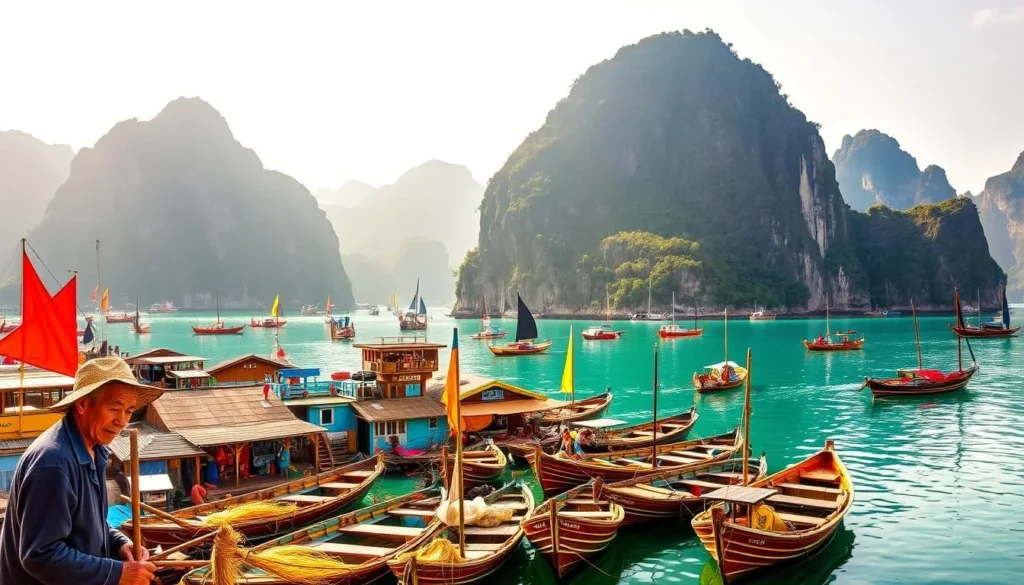
Learning Traditional Cooking
Halong Bay also offers the opportunity to indulge in its culinary heritage through cooking classes on many cruises. You can learn to prepare traditional Vietnamese dishes such as spring rolls and local seafood specialties. Be sure to try “cha muc” (squid patties), a regional delicacy that showcases the flavors of Halong Bay. These cooking classes not only teach you new recipes but also provide insight into the local ingredients and cooking techniques.
- Discover the secrets of Vietnamese cuisine
- Learn to prepare local delicacies like “cha muc”
- Enjoy the fruits of your labor on board or on shore
These cultural experiences in Halong Bay provide a deeper understanding of the destination’s human history, which spans thousands of years. By engaging with local communities and learning about their traditions, you enrich your visit and contribute to the preservation of this unique cultural heritage.
Beyond the Main Bay: Lan Ha and Bai Tu Long
Halong Bay’s lesser-known neighbors, Lan Ha Bay and Bai Tu Long Bay, provide a peaceful retreat. While they share the same geological features of limestone karsts rising from emerald waters, each bay has its own distinct charm.

Lan Ha Bay: The Quieter Alternative
Lan Ha Bay is part of the Ha Long Bay-Cat Ba Archipelago, recognized as a UNESCO World Heritage Site in 2023. It boasts approximately 400 limestone islands and 139 pristine beaches, making it an ideal spot for swimming and water sports. You can access Lan Ha Bay from Cat Ba Island, which is about a 2-hour journey from Hanoi by shuttle bus or car.
Cat Ba Island serves as a great base for exploring Lan Ha Bay, offering additional activities like rock climbing and hiking. As an active traveler, you’ll appreciate the serene landscapes and numerous opportunities for adventure.
Bai Tu Long Bay: Off the Beaten Path
Bai Tu Long Bay is located 30 km east of Halong Bay, featuring 3,000 islets across 560 square kilometers. This bay offers more off-the-beaten-path attractions, such as Bai Tu Long National Park, Thien Canh Son cave, and Vung Vieng fishing village. If you’re seeking a tranquil experience, Bai Tu Long Bay is the perfect destination.
| Bay | Fame | Crowds | Activities |
|---|---|---|---|
| Halong Bay | Famous | Crowded | Developed tourist infrastructure |
| Lan Ha Bay | Less known | Becoming crowded | Water sports, rock climbing, hiking |
| Bai Tu Long Bay | Off the beaten path | Fewer crowds | Exploring national parks, caves, fishing villages |
Choosing the right bay depends on your preferences. If you prefer a more peaceful experience, consider cruises that visit Lan Ha Bay and Bai Tu Long Bay. Each bay offers a unique experience, so you’re sure to find one that suits your taste.
Where to Stay in Halong Bay
When planning your trip to Halong Bay, choosing the right accommodation is crucial for a memorable experience. Halong Bay offers a range of lodging options, from luxury resorts to budget-friendly guesthouses, catering to the diverse needs of its visitors.
Luxury Resorts
For those seeking a luxurious experience, Halong Bay is home to top-tier resorts like Vinpearl Resort & Spa Halong, Novotel Halong, and Halong Plaza Hotel. These luxury resorts offer premium amenities, including spas, fine dining restaurants, and stunning bay views, ensuring a comfortable and indulgent stay.
Budget-Friendly Options
If you’re traveling on a budget, Halong City offers a variety of mid-range and budget-friendly accommodations that serve as convenient bases for day trips to the bay. Additionally, staying on a cruise is considered the most immersive way to experience Halong Bay, with options ranging from basic to 5-star luxury. Cat Ba Island is another alternative base with a range of accommodation options and easy access to Lan Ha Bay.
When choosing your accommodation, consider factors such as proximity to attractions, views, and included amenities. Many properties offer stunning views of the bay, allowing you to enjoy the scenery even from your lodgings. It’s recommended to book your accommodations well in advance, especially during peak seasons from October to December, when availability becomes limited.
Tips for Avoiding Crowds in Halong Bay
Halong Bay’s stunning landscapes attract millions, but with a few insider tips, you can enjoy a more serene experience. As a popular destination, it’s inevitable to encounter crowds, but there are strategies to make your visit more peaceful.
Best Routes for a Peaceful Experience
Choosing the right route can significantly impact your experience in Halong Bay. Consider cruises that explore Bai Tu Long Bay or Lan Ha Bay instead of the main Halong Bay route for fewer tourists but similar stunning scenery. Opting for smaller junk boats with a maximum of 30 guests can also provide a more intimate experience compared to larger vessels.

Timing Your Visit
Timing is everything when visiting Halong Bay. Traveling during off-peak months (March-May or September-October) can help you avoid the biggest crowds. Booking a 3-day, 2-night itinerary allows you to reach quieter areas of the bay. Additionally, weekdays are generally less crowded than weekends, especially for day trips. Early morning or late afternoon excursions can also be beneficial as many day-trippers have not yet arrived or have already departed.
Conclusion: Making the Most of Your Halong Bay Adventure
Halong Bay, with its emerald waters and towering limestone formations, offers an unforgettable experience. As a UNESCO World Heritage Site, it captivates visitors with its breathtaking scenery and diverse activities. You can explore caves like Sung Sot and Thien Cung, visit floating villages like Cua Van, or enjoy kayaking and night squid fishing. Choosing the right cruise is crucial for a memorable trip. Plan ahead, considering factors like weather and crowd levels, to make the most of your Halong Bay adventure and help preserve this natural wonder for future generations.
The above is subject to change.
Check back often to TRAVEL.COM for the latest travel tips and deals.
